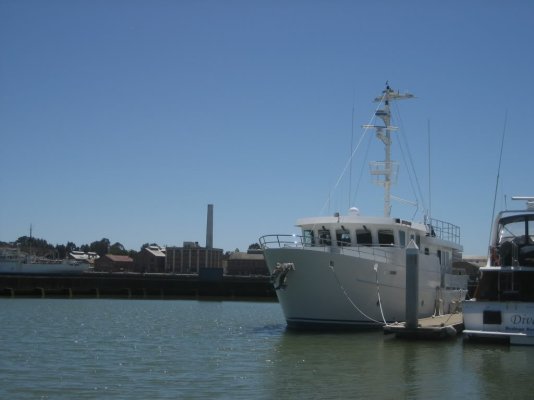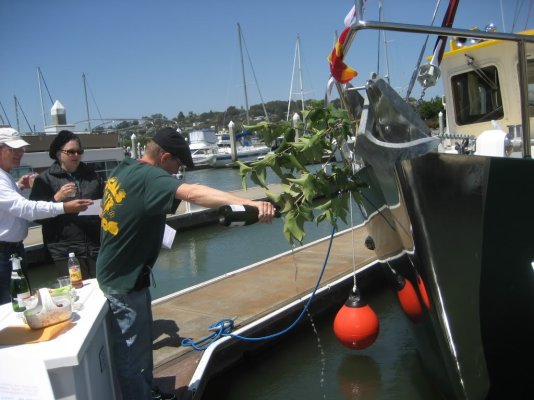sunchaser wrote:
Richard, while not disagreeing with your findings, it is*incongruent that both you and Marin replaced smaller Bruce's with bigger Rocna's. Rocna's hype is that a superior design allows for a lighter anchor.
So my take is you both are happier with* 50-100% heavier anchors.*That one fact alone makes a lot of sense.
*
Our Rocna is not 50% larger than our Bruce.* It is just one size up-- only eleven pounds heavier--- the same weight as the Bruces on some of our friend's* 36' boats' who have experienced numerous instances of their Bruce dragging or breaking free under pressure.* Thats my whole point--- going from a 33# to a 44# Bruce apparently makes zero difference to the holding power for a boat the size and weight of ours and the boats of people we know who've had the same experience.
Besides, while weight certainly contributes to an anchor's effectiveness, the design is much more important I believe.* If this was not true, the Fortress wouldn't work, yet it consistently tops out the tests as having the best holding in the bottoms for which its design is suited.* Simply looking at a Bruce design, and the design of a Rocna, Sarca, Manson, Super Max, Danforth, Eric's XYZ, even a CQR, it seems obvious to me why the Bruce has such low holding power.* At the time we bought our Bruce we knew virtually nothing about anchors and anchor designs so we went with what was the most popular in this area for boats like our GB.* Now, 13 years later, we know a lot more about anchors and how their designs work, or don't work.
I'm sorry but after our several years of experience with a Bruce, and the experience of a fair number of other boaters we've met who have, or had, a Bruce, I will never be convinced that it is an anchor to be trusted in the smaller sizes that are used on boats like ours.* If our next boat was a North Sea oil exploration rig, you bet, I'd be in line for a Bruce with a semi-tractor and lowboy trailer to carry it to the rig.* But for a 36' foot boat like ours, I consider a "properly" sized Bruce to be no more reliable than a rock.* And not a very big rock at that.
We've had a few people ask to buy our Bruce since we aren't using it any more and Bruce no longer makes small anchors..* We won't sell it to them because we believe selling something has has proven itself to be unreliable-- particularly a safety item like an anchor--- is irresponsible.* If the day comes we don't need it to prop open the door in our garage we will throw it away.
Eric says the Bruce is common and very popular up in his neck of the woods.* It is down here, too, probably even more so.* It's why we bought one.* But every comment we heard at the time about the benefits of the Bruce referred to its ability to set in a variety of bottoms.* NOBODY said a word about holding power, probably because in our mostly protected anchorages here people aren't faced with riding out 50-knot winds and big waves.* So we bought a Bruce.
Worked great under the typical 0-20 knot conditions we get here.* But when the wind kicked up higher or the bottom was less ideal for its design, it invariably grew legs and wandered off.* If it had just been us having this problem we would have looked to our anchoring technique.* But we heard-- and still hear--- this same story time and time again from other boaters.
Bottom line is that, regardless of the "never had a problem with our Bruce" testimonials from other boaters, including ones on this forum, we simply lost our faith in it and no longer trusted it.* At anchor, if the wind blew at all at night, we would lie in our berth worrying if it was going to blow harder and if it did would the Bruce hold.* And if you can't trust your ground tackle, it's time to look for something different.* The experiences of other boaters is irrelevant-- the only thing that matters is what happens with your boat.* And the Bruce let us down too many times to be considered reliable.* The fact it was letting down a lot of other boaters we knew was just the icing on the cake.* So it went.
Eric has rightly said that if we'd have had a larger Bruce it would have worked for us.* We know that going from a 33# to a 44# Bruce would have made no difference in reliability at all.* So based on what I've heard, read, and observed in the years we've been doing this kind of boating, for a Bruce to be truly effective and reliable on our boat, it would have to be 70 or 80 or 100 pounds in weight.* And we're simply not set up to deal with an anchor that large and heavy.* So we went with an anchor with a superior design instead.
-- Edited by Marin on Saturday 22nd of October 2011 12:52:09 PM

